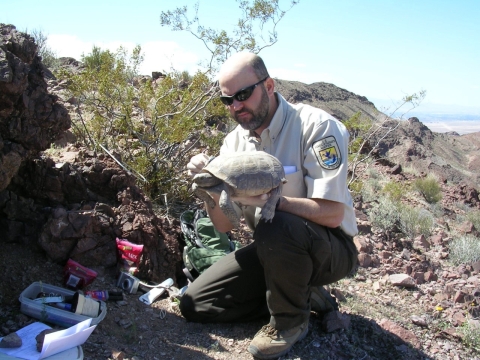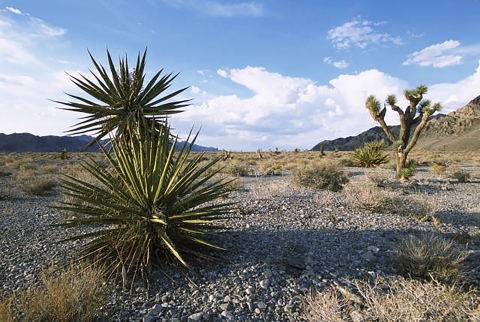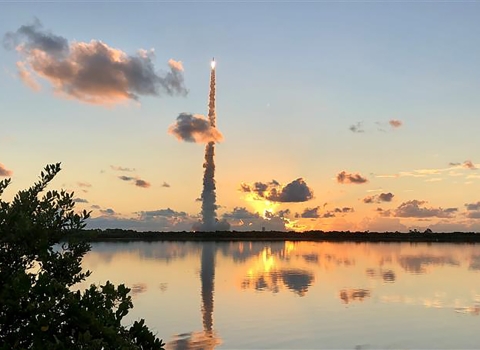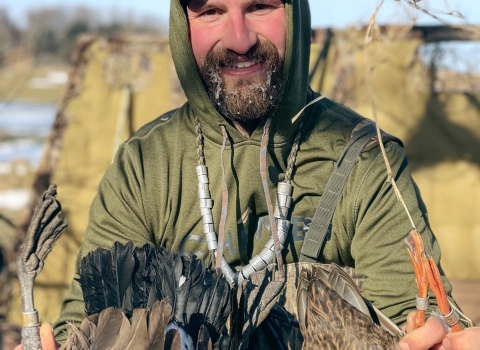Roy Averill-Murray is our latest FWS Scholar who is the Desert Tortoise Recovery Coordinator for the U.S. Fish & Wildlife Service. He’s inquisitive, persistent, and dedicated to conservation. Roy grew up in Texas and has been interested in amphibians, turtles and reptiles from a young age, as you can see by his award-winning, first-grade painting of a turtle below. But his path as a Wildlife Biologist was firmly established at Texas A&M University, where he earned his B.S. in Wildlife and Fisheries Science and had the opportunity working as a Field Technician for two summers on a water snake project.
He then earned his M.S in Wildlife and Fisheries Science from the University of Arizona, where he completed his thesis on estimating density and abundance of Sonoran desert tortoises. Roy worked for the Arizona Game and Fish Department as Desert Tortoise Coordinator from 1995 to 2002 and as Amphibians and Reptiles Program Manager from 2002 to 2004. He has been in his current role in Reno, Nevada as Desert Tortoise Recovery Coordinator for the U.S. Fish & Wildlife Service ever since.
Famous for its harsh and arid conditions, the Mojave Desert is far from an empty desert wasteland, it’s home to countless animals and plants including the Mojave desert tortoise, which is federally listed as threatened under the Endangered Species Act. The Mojave desert tortoise is a keystone species, which means it has a higher influence over the ecosystem than other species. Many other species use their burrows and benefit from having the desert tortoises around, including the Gila monster, collared peccaries, roadrunners, and burrowing owls. Desert tortoises are equipped to thrive in the xeric desert; they use their powerful front legs for the perfect burrow away from the heat and can retract fully into their shell, safe from both predators and the smoldering sun. These slow and stocky turtles can live to 30–50 years old in the wild, sometimes even 80 years old! Due to habitat destruction desert tortoises are struggling for survival.
As Desert Tortoise Recovery Coordinator, Roy works with internal and external partners to implement recovery actions across the range of the Mojave desert tortoise in California, Nevada, Utah and Arizona. His favorite part of the job and one of the reasons it was created, is facilitating the application of research and monitoring results to on-the-ground conservation of desert tortoises.
The Mojave desert tortoise is considered to be a conservation-reliant species, no longer able to survive on its own. The biggest threats to the species is habitat degradation, which includes activities like urban development, mining, military training, livestock grazing and proliferation of invasive plants. “Another main threat to desert tortoises is habitat fragmentation by roads, which pose a significant threat to the long-term persistence of local tortoise populations. Connectivity of their populations has become an issue of increasing concern with much of this habitat being developed with the recent renewable energy boom (Averill-Murray, et. al, 2021).
Roy has published over 30 papers and book chapters, primarily on applied conservation projects on Mojave and Sonoran desert tortoises. He’s written on topics like population connectivity, effects of translocation projects, and reproduction and life history, among others.
One of the studies Roy was a part of, investigated the relationships between habitat characteristics and translocation outcomes, in particular dispersal and survival, for juvenile Mojave desert tortoises. In the article it says, “Translocation, or assisted movement of wildlife, is a widely used management tool and can be helpful with species recovery through population reintroduction and reinforcement. Because conservation translocations can contribute to species recovery, refinement of translocation protocols is necessary to support successful translocations, especially for juvenile tortoises.”
One example of connecting research to management was the incorporation of a published model of desert tortoise population linkages into conservation designations as part of the Desert Renewable Energy Conservation Plan in California.
To learn more about Roy Averill-Murray’s research on desert tortoise recovery, check out his recently published report titled, Connectivity of Mojave Desert Tortoise Populations:Management Implications for Maintaining a Viable Recovery Network. For more on his work view his full list of publications, discoverable via USFWS Conservation Library. #FWSscholar is brought to you by the USFWS Conservation Library, #WeAreUSFWS.









